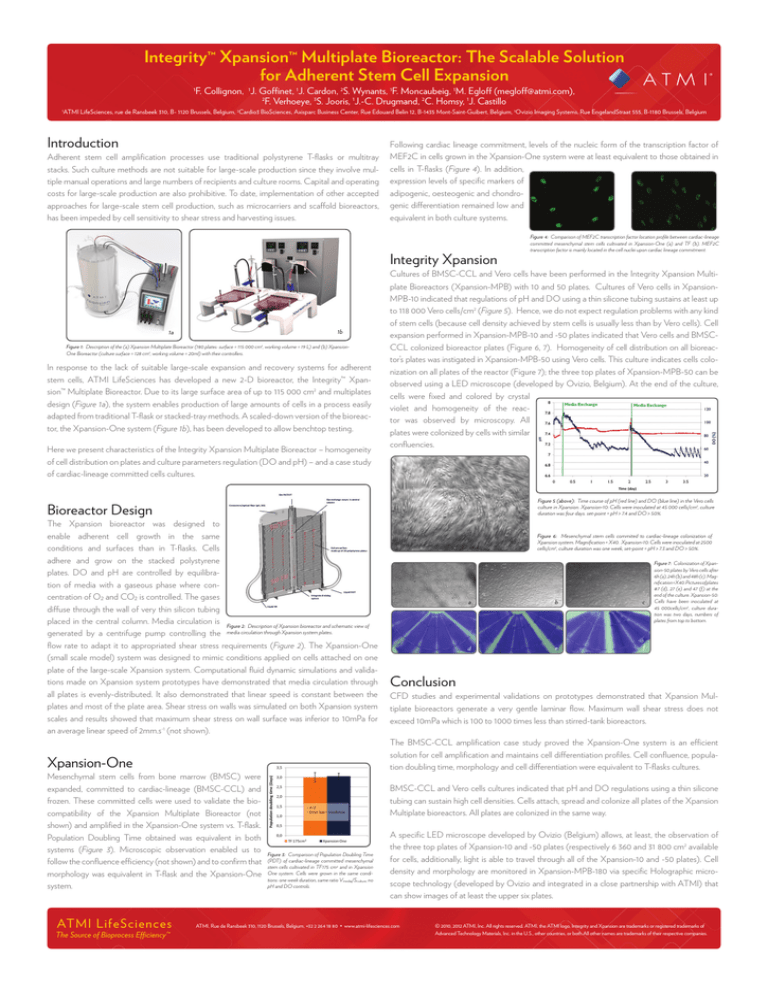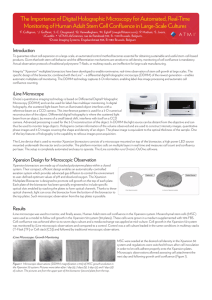
Integrity™ Xpansion™ Multiplate Bioreactor: The Scalable Solution
for Adherent Stem Cell Expansion
1
1
F. Collignon, 1J. Goffinet, 1J. Cardon, 2S. Wynants, 1F. Moncaubeig, 1M. Egloff (megloff@atmi.com),
2
F. Verhoeye, 3S. Jooris, 1J.-C. Drugmand, 2C. Homsy, 1J. Castillo
ATMI LifeSciences, rue de Ransbeek 310, B- 1120 Brussels, Belgium, 2Cardio3 BioSciences, Axisparc Business Center, Rue Edouard Belin 12, B-1435 Mont-Saint-Guibert, Belgium, 3Ovizio Imaging Systems, Rue EngelandStraat 555, B-1180 Brussels, Belgium
Introduction
Adherent stem cell amplification processes use traditional polystyrene T-flasks or multitray
stacks. Such culture methods are not suitable for large-scale production since they involve multiple manual operations and large numbers of recipients and culture rooms. Capital and operating
costs for large-scale production are also prohibitive. To date, implementation of other accepted
approaches for large-scale stem cell production, such as microcarriers and scaffold bioreactors,
has been impeded by cell sensitivity to shear stress and harvesting issues.
Following cardiac lineage commitment, levels of the nucleic form of the transcription factor of
MEF2C in cells grown in the Xpansion-One system were at least equivalent to those obtained in
cells in T-flasks (Figure 4). In addition,
expression levels of specific markers of
adipogenic, oesteogenic and chondrogenic differentiation remained low and
equivalent in both culture systems.
Integrity Xpansion
Figure 4: Comparison of MEF2C transcription factor location profile between cardiac-lineage
committed mesenchymal stem cells cultivated in Xpansion-One (a) and TF (b). MEF2C
transcription factor is mainly located in the cell nuclei upon cardiac lineage commitment.
Cultures of BMSC-CCL and Vero cells have been performed in the Integrity Xpansion Multi-
1b
1a
Figure 1: Description of the (a) Xpansion Multiplate Bioreactor (180 plates: surface = 115 000 cm2, working volume = 19 L) and (b) XpansionOne Bioreactor (culture surface = 128 cm2, working volume = 20ml) with their controllers.
In response to the lack of suitable large-scale expansion and recovery systems for adherent
stem cells, ATMI LifeSciences has developed a new 2-D bioreactor, the Integrity™ Xpansion™ Multiplate Bioreactor. Due to its large surface area of up to 115 000 cm2 and multiplates
design (Figure 1a), the system enables production of large amounts of cells in a process easily
adapted from traditional T-flask or stacked-tray methods. A scaled-down version of the bioreactor, the Xpansion-One system (Figure 1b), has been developed to allow benchtop testing.
Here we present characteristics of the Integrity Xpansion Multiplate Bioreactor – homogeneity
of cell distribution on plates and culture parameters regulation (DO and pH) – and a case study
of cardiac-lineage committed cells cultures.
plate Bioreactors (Xpansion-MPB) with 10 and 50 plates. Cultures of Vero cells in XpansionMPB-10 indicated that regulations of pH and DO using a thin silicone tubing sustains at least up
to 118 000 Vero cells/cm2 (Figure 5). Hence, we do not expect regulation problems with any kind
of stem cells (because cell density achieved by stem cells is usually less than by Vero cells). Cell
expansion performed in Xpansion-MPB-10 and -50 plates indicated that Vero cells and BMSCCCL colonized bioreactor plates (Figure 6, 7). Homogeneity of cell distribution on all bioreactor’s plates was instigated in Xpansion-MPB-50 using Vero cells. This culture indicates cells colonization on all plates of the reactor (Figure 7); the three top plates of Xpansion-MPB-50 can be
observed using a LED microscope (developed by Ovizio, Belgium). At the end of the culture,
cells were fixed and colored by crystal
violet and homogeneity of the reactor was observed by microscopy. All
plates were colonized by cells with similar
confluencies.
Figure 5 (above): Time course of pH (red line) and DO (blue line) in the Vero cells
culture in Xpansion. Xpansion-10: Cells were inoculated at 45 000 cells/cm2, culture
duration was four days. set-point = pH > 7.4 and DO > 50%.
Bioreactor Design
The Xpansion bioreactor was designed to
enable adherent cell growth in the same
conditions and surfaces than in T-flasks. Cells
adhere and grow on the stacked polystyrene
plates. DO and pH are controlled by equilibration of media with a gaseous phase where concentration of O2 and CO2 is controlled. The gases
diffuse through the wall of very thin silicon tubing
placed in the central column. Media circulation is Figure 2: Description of Xpansion bioreactor and schematic view of
generated by a centrifuge pump controlling the media circulation through Xpansion system plates.
flow rate to adapt it to appropriated shear stress requirements (Figure 2). The Xpansion-One
(small scale model) system was designed to mimic conditions applied on cells attached on one
plate of the large-scale Xpansion system. Computational fluid dynamic simulations and validations made on Xpansion system prototypes have demonstrated that media circulation through
all plates is evenly-distributed. It also demonstrated that linear speed is constant between the
plates and most of the plate area. Shear stress on walls was simulated on both Xpansion system
scales and results showed that maximum shear stress on wall surface was inferior to 10mPa for
an average linear speed of 2mm.s-1 (not shown).
ATMI LifeSciences
The Source of Bioprocess Efficiency™
a
b
c
d
e
f
Figure 7: Colonization of Xpansion-50 plates by Vero cells after
6h (a), 24h (b) and 48h (c). Magnification =X40. Pictures of plates
#7 (d), 27 (e) and 47 (f) at the
end of the culture. Xpansion-50:
Cells have been inoculated at
45 000cells/cm2, culture duration was two days, numbers of
plates from top to bottom.
Conclusion
CFD studies and experimental validations on prototypes demonstrated that Xpansion Multiplate bioreactors generate a very gentle laminar flow. Maximum wall shear stress does not
exceed 10mPa which is 100 to 1000 times less than stirred-tank bioreactors.
The BMSC-CCL amplification case study proved the Xpansion-One system is an efficient
solution for cell amplification and maintains cell differentiation profiles. Cell confluence, population doubling time, morphology and cell differentiation were equivalent to T-flasks cultures.
Xpansion-One
Mesenchymal stem cells from bone marrow (BMSC) were
expanded, committed to cardiac-lineage (BMSC-CCL) and
frozen. These committed cells were used to validate the biocompatibility of the Xpansion Multiplate Bioreactor (not
shown) and amplified in the Xpansion-One system vs. T-flask.
Population Doubling Time obtained was equivalent in both
systems (Figure 3). Microscopic observation enabled us to
follow the confluence efficiency (not shown) and to confirm that
morphology was equivalent in T-flask and the Xpansion-One
system.
Figure 6: Mesenchymal stem cells commited to cardiac-lineage colonization of
Xpansion system. Magnification = X40. Xpansion-10: Cells were inoculated at 2500
cells/cm2, culture duration was one week, set-point = pH > 7.3 and DO > 50%.
BMSC-CCL and Vero cells cultures indicated that pH and DO regulations using a thin silicone
tubing can sustain high cell densities. Cells attach, spread and colonize all plates of the Xpansion
Multiplate bioreactors. All plates are colonized in the same way.
Figure 3: Comparison of Population Doubling Time
(PDT) of cardiac-lineage committed mesenchymal
stem cells cultivated in TF175 cm2 and in Xpansion
One system. Cells were grown in the same conditions: one week duration, same ratio Vmedia/Sculture, no
pH and DO controls.
A specific LED microscope developed by Ovizio (Belgium) allows, at least, the observation of
the three top plates of Xpansion-10 and -50 plates (respectively 6 360 and 31 800 cm2 available
for cells, additionally, light is able to travel through all of the Xpansion-10 and -50 plates). Cell
density and morphology are monitored in Xpansion-MPB-180 via specific Holographic microscope technology (developed by Ovizio and integrated in a close partnership with ATMI) that
can show images of at least the upper six plates.
ATMI, Rue de Ransbeek 310, 1120 Brussels, Belgium, +32 2 264 18 80 • www.atmi-lifesciences.com
© 2010, 2012 ATMI, Inc. All rights reserved. ATMI, the ATMI logo, Integrity and Xpansion are trademarks or registered trademarks of
Advanced Technology Materials, Inc. in the U.S., other countries, or both.All other names are trademarks of their respective companies.









